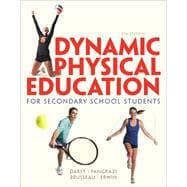
Note: Supplemental materials are not guaranteed with Rental or Used book purchases.
Purchase Benefits
Lead author Paul W. Darst received a Ph.D in Physical Education from the Ohio State University. He is a professor and Department Chair at Arizona State University at the Polytechnic Campus in the area of Physical Education-Teacher Preparation. His research and teaching focuses on secondary school physical education curriculum, methods of teaching in the secondary schools, and activity habits of middle and high school students. He has been active professionally at the state, district and national levels of AAHPERD and has received numerous honors and speaking invitations.
In addition to co-authoring the previous edition of this text (Dynamic Physical Education for Secondary School Students, 7/e, Pearson, 2012) with Bob Pangrazi, and serving as its lead author, Darst also authored Outdoor Adventure Activities for School and Recreation Programs (Waveland Press), Analyzing Physical Education and Sport Instruction (Human Kinetics), and Cycling (Scott, Foresman and Company, Sport for Life Series). He has written many articles and made numerous presentations to teachers on new ideas in teaching and on working with students.
Co-lead author Robert P. Pangrazi is an internationally recognized expert in physical education training and instruction. He is professor emeritus at Arizona State University and an Educational Consultant for HopSports and The U.S. Tennis Association. His physical education textbooks have sold over 750,000 copies in this country and abroad. Pangrazi has published over 50 textbooks and 100 research and professional articles. He has been a keynote speaker for 39 state and district conventions and an invited speaker at nearly 400 national and international conferences. He regularly conducts training sessions for schools and universities and works regularly as a motivational speaker. His approach to elementary school physical education has been used worldwide by the Department of Defense Dependents’ Schools, nationally by the Edison Project, and is used in hundreds of public, private and charter schools across the U.S.
Dr. Pangrazi has received numerous awards including the Distinguished Service Award from the President’s Council on Physical Fitness and Sports, the National Distinguished Service Award presented by the AAHPERD Council on Physical Education for Children, and the Curriculum and Instruction Emeritus Honor Award from the NASPE Curriculum and Instruction Academy He is a Fellow in the American Academy of Kinesiology and Physical Education and an AAHPERD Honor Fellow.
Heather Erwin earned her Ph.D. from the University of Illinois at Urbana-Champaign in Kinesiology in 2006. She is currently an associate professor in the Department of Kinesiology and Health Promotion at the University of Kentucky, Lexington, specializing in physical education teacher education. Her research focus is on school-based physical activity, with an emphasis on physical education, classroom physical activity, and recess settings. Dr. Erwin has taught elementary physical education in Springdale, AR, worked with summer recreation programs for over 10 years, taught numerous training workshops on child and adolescent physical activity, and conducted extensive research in school settings. She has authored or co-authored multiple articles—both research-based and applied—on the promotion of physical activity and youth activities, and has been a contributor to and author of numerous Pearson supplements.
I. JUSTIFYING A PHYSICAL EDUCATION PROGRAM
1. Physical Education in the Secondary School
2. The Impact of Physical Activity on Adolescents
II. DESIGNING A PHYSICAL EDUCATION PROGRAM
3. Steps in Developing a Curriculum
4. Curriculum Approaches
III. TEACHING A PHYSICAL EDUCATION PROGRAM
5. Planning for Effective Instruction
6. Improving Instructional Effectiveness
7. Management and Discipline
8. Teaching Styles
9. Improving Instruction Systematically
10. Assessment, Evaluation, Grading, and Program Accountability
IV. DEVELOPING A TOTAL PROGRAM
11. Students with Disabilities
12. Liability and Safety
13. Intramurals, Sport Clubs, and Athletics: Furthering the Opportunity for Physical Activity
V. IMPLEMENTING INSTRUCTIONAL ACTIVITIES
14. Introductory Activities
15. Technology and Other Tools to Promote and Monitor Lifestyle Physical Activity
16. Physical Fitness
17. Healthy Lifestyles: Activities for Instruction
18. Promoting Motivation, Cooperation, and Inclusion: Nontraditional Ideas for Instruction
19. Sports
20. Lifestyle Activities
21. Outdoor Adventure Activities
References and Suggested Readings
Index
The New copy of this book will include any supplemental materials advertised. Please check the title of the book to determine if it should include any access cards, study guides, lab manuals, CDs, etc.
The Used, Rental and eBook copies of this book are not guaranteed to include any supplemental materials. Typically, only the book itself is included. This is true even if the title states it includes any access cards, study guides, lab manuals, CDs, etc.